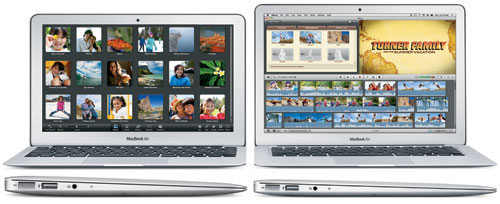Hosted by site sponsor WebMate.
MacBook Air Q&A
Revision Published July 3, 2013
All Mac Q&As >> MacBook Air Q&A (Home) | Also See: All MacBook Air Specs
To be notified of new Q&As, sign up for EveryMac.com's bimonthly email list.
What are the "pros and cons" of the "Late 2010" and "Mid-2011" MacBook Air models?
Please note that the "Late 2010" and "Mid-2011" MacBook Air models have been discontinued. However, this Q&A is up-to-date and can be particularly useful for anyone considering one of these MacBook Air systems on the used market. These MacBook Air models can be identified externally by the A1369 and A1370 model numbers.
For the current MacBook Air models, EveryMac.com also provides an up-to-date pros and cons rundown that also may be of interest.
Like any other decision, only you can determine whether or not a used "Late 2010" or "Mid-2011" MacBook Air model is the right notebook for you, but you can evaluate the pros and cons of the series to see if your needs are met. EveryMac.com also offers a detailed comparison of these two lines that you may additionally wish to review.

Photo Credit: Apple, Inc. (Left - 11" MacBook Air, Right - 13" MacBook Air)
For those most interested in the highlights, this "run down" may be helpful in making a decision:
Pros:
- Very lightweight, beautiful, thin case designs.
- Extremely long "standby" time of an Apple-reported 30 days.
- Both the "Late 2010" and "Mid-2011" models provide respectable speed, often due to flash storage. Can often hold their own compared to 13-Inch MacBook and MacBook Pro models released at the same time.
- LED-backlit widescreen displays that are high-resolution for the physical dimensions (1440x900 for the 13-Inch model).
- Essentially full-size keyboards despite compact system dimensions.
- Full featured "inertial" multi-touch trackpad.
- Both the "Late 2010" and "Mid-2011" models provide generally excellent battery life.
- Two USB 2.0 ports.
- SD Card reader (13-Inch models only).
- Backlit keyboard ("Mid-2011" models only)
- Thunderbolt port provides the option of high speed peripherals as well as external display connectivity ("Mid-2011" models only).
- Relatively affordable at the time of introduction (and even more affordable on the used market, of course).
Cons:
- Woefully inadequate 2 GB of RAM by default in all "Late 2010" models and the entry-level MC968LL/A configuration of the MacBook Air "Core i5" 1.6 11-Inch (Mid-2011) as well. RAM cannot be upgraded after purchase (either model could be upgraded to 4 GB of RAM at the time of purchase only, so a system with 4 GB of RAM should be considered more valuable on the used market as it likely will be usable longer).
- Modest internal storage that is not intended to be upgraded by an end user.
- Battery is not easy to access or replace and is not intended to be replaced by an end user, either.
- Keyboard is not backlit (Late 2010 models only, the Mid-2011 models have a backlit keyboard).
- No internal Ethernet (a 10/100Base-T Ethernet adapter is available, but no Gigabit Ethernet connectivity is possible).
- No Firewire port.
- No remote (IR) support.
- No internal optical drive (external option available).
- Upgrades (additional RAM and storage) and accessories (optical drive) can make the MacBook Air more expensive than alternatives should a user need these additions.
Ultimately, if you are looking for a beautiful, lightweight notebook Mac on the used market and have fairly modest performance needs, as well as limited expansion and connectivity needs -- then one of these MacBook Air systems might be perfect for you.
Those interested in getting the most life out of one of these systems should look for one with 4 GB of RAM whereas one most interested in price or who does not intend to own the system for a long time might consider a system with 2 GB of RAM instead to save money.
If performance, connectivity and expansion are high priorities -- but size, weight, and sleek design are lower priorities -- a used MacBook Pro could be a better choice. If price is the highest priority, a used MacBook also could be a worthwhile option.
In the US, site sponsor Other World Computing sells used and refurb MacBook Air models at bargain prices with free shipping, as well. On the other hand, if you need to sell a MacBook Air, A+ BBB-rated Cash for Your Mac and GoRoostr will buy your older notebook with an instant quote and prompt payment.
In the UK, site sponsor Hoxton Macs sells used MacBook Air models with a one-year warranty and free next day delivery throughout the UK. Delivery across Europe also is available starting at just £9.99 for two-day delivery to France and Germany.
Permalink | Report an Error/Typo | Sign Up for Site Update Notices
Established in 1996, EveryMac.com has been created by experts with decades of experience with Apple hardware. EveryMac.com includes, and always has included, original research incorporating detailed, hands-on inspection of packaging, computers, and devices as well as extensive real-world use. All information is provided in good faith, but no website or person is perfect. Accordingly, EveryMac.com is provided "as is" without warranty of any kind whatsoever. EveryMac.com, and the authors thereof, shall not be held responsible or liable, under any circumstances, for any damages resulting from the use or inability to use the information within. For complete disclaimer and copyright information please read and understand the Terms of Use and the Privacy Policy before using EveryMac.com. Copying, scraping, or use of any content without expressed permission is not allowed, although links to any page are welcomed and appreciated.
